The Pacific Reef Heron (Egretta sacra) is a captivating emblem of coastal ecosystems across the Asia-Pacific region. With its striking color-changing ability and adaptable nature, this avian species enthralls bird enthusiasts and scientists alike.
Found in diverse habitats such as rocky shores, coral reefs, and mangroves, the Pacific Reef Heron plays a vital role in maintaining ecological balance through its predation on fish and crustaceans.
Despite its widespread distribution, habitat loss, human disturbance, and climate change loom over its existence, it is underscoring the importance of conservation efforts.
Understanding and protecting the Pacific Reef Heron ensures the preservation of a charismatic coastal bird and contributes to the broader conservation of marine ecosystems.
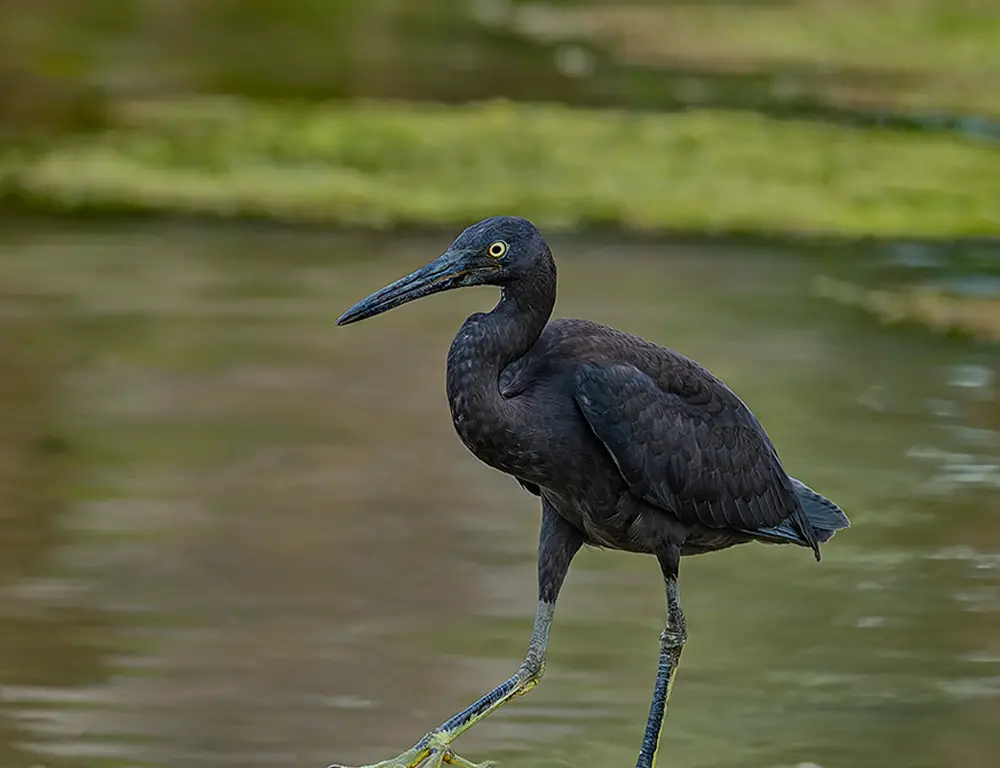
Physical Characteristics of Pacific Reef Heron
The Pacific Reef Heron (Egretta sacra) is a striking bird with distinct physical characteristics that set it apart from other heron species. Here’s an overview of its physical attributes:
Size
Pacific Reef Herons are medium-sized herons, with adults typically measuring between 60 and 70 centimeters (approximately 24 and 28 inches) in height. They have a wingspan ranging from 90 to 110 centimeters (approximately 35 to 43 inches).
Color Morphs
One of the most notable features of the Pacific Reef Heron is its ability to change color. Individuals can exhibit two main color morphs: dark grey and pure white.
The dark morph is predominantly charcoal-grey throughout its body, while the light morph has white plumage on its underparts contrasting with grey upperparts.
Plumage
Regardless of color morph, Pacific Reef Herons have sleek plumage with long, slender necks and pointed bills. Their feathers are generally smooth and streamlined, facilitating efficient flight and movement through coastal environments.
Legs and Feet
These herons have yellowish-green legs and feet, which provide a striking contrast against their subdued plumage. Their legs are long and slender, adapted for wading through shallow waters while hunting for prey.
Beak
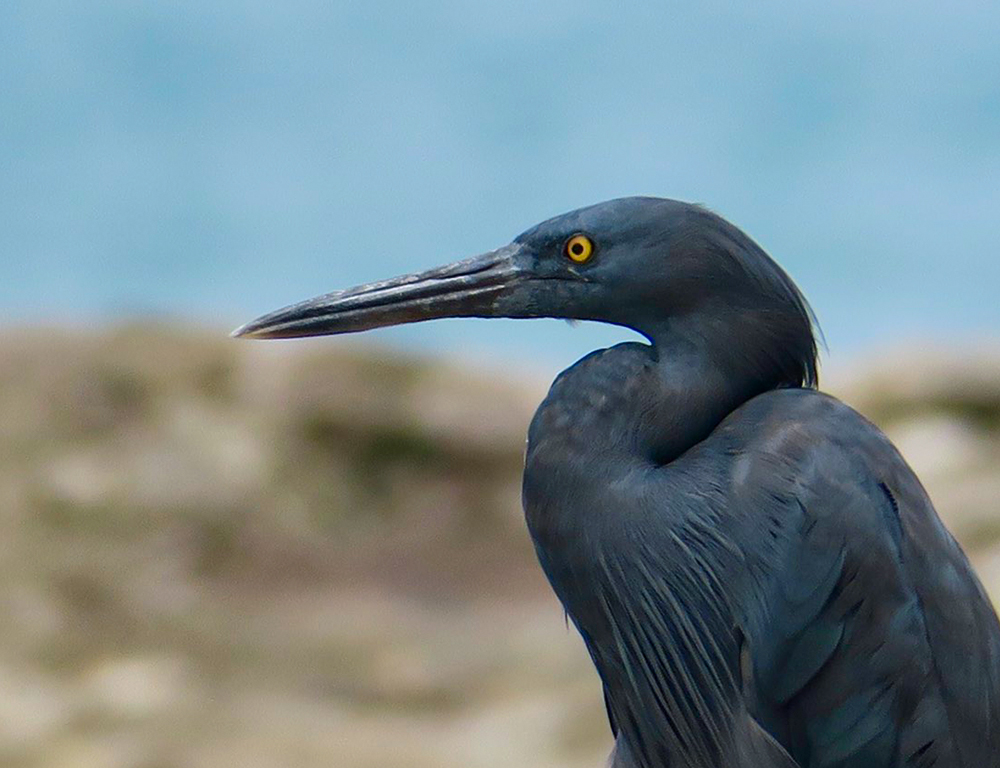
Pacific Reef Herons possess long, dagger-like bills for capturing fish and other aquatic prey. Their bills are sharp and pointed, allowing for precise strikes when hunting.
Eyes
Like most birds, Pacific Reef Herons have keen eyesight, which aids them in spotting prey from a distance. Their eyes are typically dark-colored and positioned on either side of their heads, providing a wide field of vision.
Sexual Dimorphism
There is generally no significant difference in appearance between male and female Pacific Reef Herons. Both sexes exhibit the same color morphs and physical characteristics.
Habitat and Distribution of Pacific Reef Heron
The Pacific Reef Heron (Egretta sacra) is a coastal bird found across a wide geographic range in the Asia-Pacific region. Here’s a closer look at its habitat and distribution:
Coastal Habitats
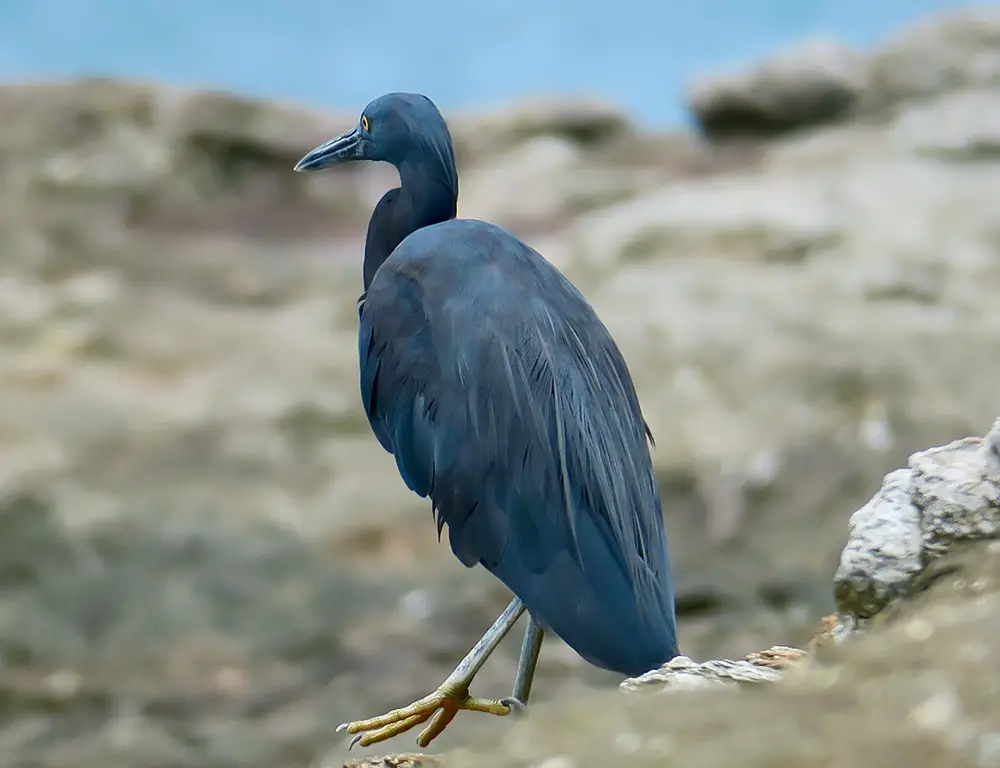
As their name suggests, Pacific Reef Herons are primarily associated with coastal environments. They inhabit various coastal habitats, including rocky shores, coral reefs, mangroves, sandy beaches, tidal flats, and estuaries.
They are well-adapted to living and foraging in these dynamic and diverse ecosystems.
Geographic Range
Pacific Reef Herons have a vast distribution range from East Asia to Australia and across to Polynesia. They can be found in Japan, China, Taiwan, the Philippines, Indonesia, Papua New Guinea, Australia, New Zealand, and various Pacific Islands.
Islands and Islets
Pacific Reef Herons often nest and roost on remote islands, rocky islets, and cliffs along coastlines. These isolated locations provide them with suitable nesting sites away from terrestrial predators and human disturbance.
Human Proximity
Despite their preference for relatively undisturbed coastal habitats, Pacific Reef Herons can also be found in areas influenced by human activity.
They may inhabit coastal areas near human settlements, including piers, jetties, harbors, and even urban waterfronts, as long as suitable foraging opportunities are available.
Tropical and Subtropical Regions
Pacific Reef Herons are adaptable birds capable of thriving in various climates. They are commonly found in tropical and subtropical regions, where they can tolerate multiple temperatures and environmental conditions.
Migration
While Pacific Reef Herons are generally sedentary birds, some populations may undertake localized movements or seasonal migrations in response to food availability or breeding behavior changes.
However, their movements are typically limited compared to migratory bird species.
Behavior and Diet of Pacific Reef Heron
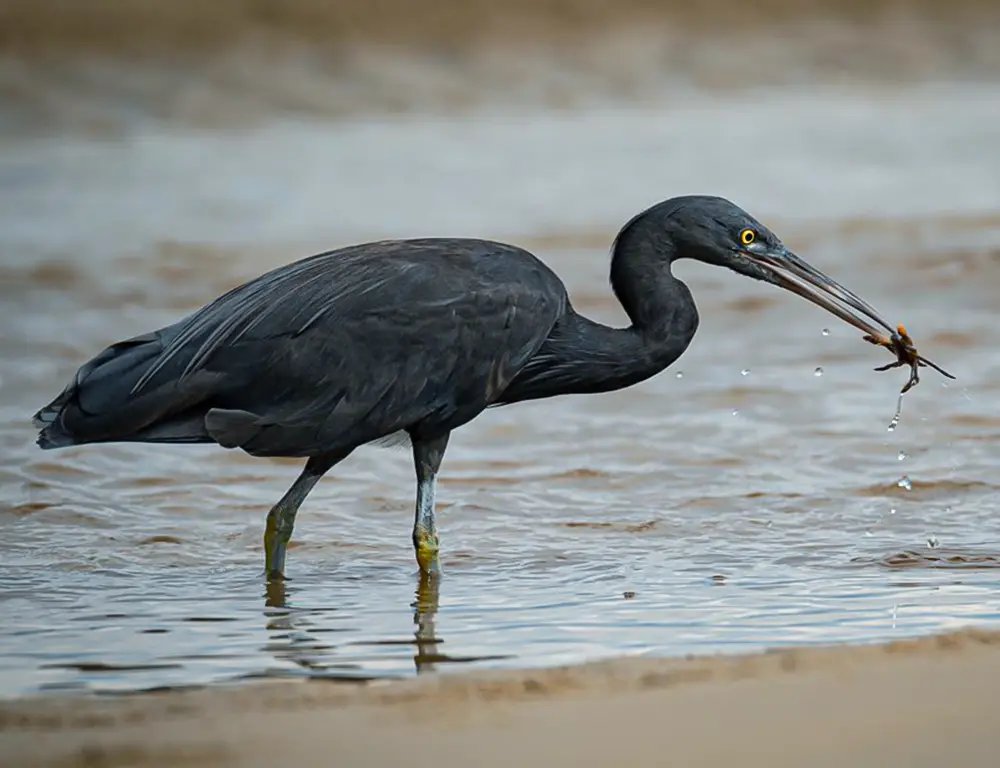
The behavior and diet of the Pacific Reef Heron (Egretta sacra) are closely tied to its coastal habitat and foraging habits.
Here’s an overview of their behavior and dietary preferences:
Behavior
- Solitary Behavior: Pacific Reef Herons are typically solitary birds, although they may form small groups, especially during breeding or foraging in areas with abundant prey. They are often observed hunting alone along rocky shores, tidal pools, and coral reefs.
- Foraging Strategy: These herons employ various foraging strategies to capture prey. Their primary method is the “stand-and-wait” tactic, where they remain motionless in shallow water or on rocky surfaces, patiently waiting for fish and crustaceans to come within striking distance. They may also engage in active hunting by strolling through shallow waters or flying low over the surface to spot prey.
- Diurnal Activity: Pacific Reef Herons are primarily diurnal, meaning they are most active during the day. They typically forage during daylight hours, taking advantage of low tide periods when prey is more accessible along coastal areas.
- Nesting and Breeding: Breeding behavior in Pacific Reef Herons varies depending on the region, but they generally nest once a year between April and July.
They build simple nests made of sticks and reeds in secluded locations such as rocky cliffs, islets, or dense vegetation near water bodies. Males and females work together to construct the nest and incubate the eggs, typically laying two to three eggs per clutch.
Diet
- Fish: Fish constitute a significant portion of the Pacific Reef Heron’s diet. They feed on various small to medium-sized fish found in coastal waters, including reef fish, juvenile fish, and baitfish.
- Crustaceans: Crustaceans such as crabs, shrimps, and prawns are also important food sources for Pacific Reef Herons. They use their sharp bills to capture and consume these crustaceans, often scavenging among rocks and tidal pools for prey.
- Insects: Besides fish and crustaceans, Pacific Reef Herons may consume aquatic insects and other invertebrates in coastal habitats. These insects provide supplementary nutrition, especially when fish and crustacean prey are scarce.
- Opportunistic Feeding: Pacific Reef Herons are opportunistic feeders and may consume other small vertebrates and invertebrates, including amphibians, reptiles, and mollusks, if available.
Conservation Status of Pacific Reef Heron
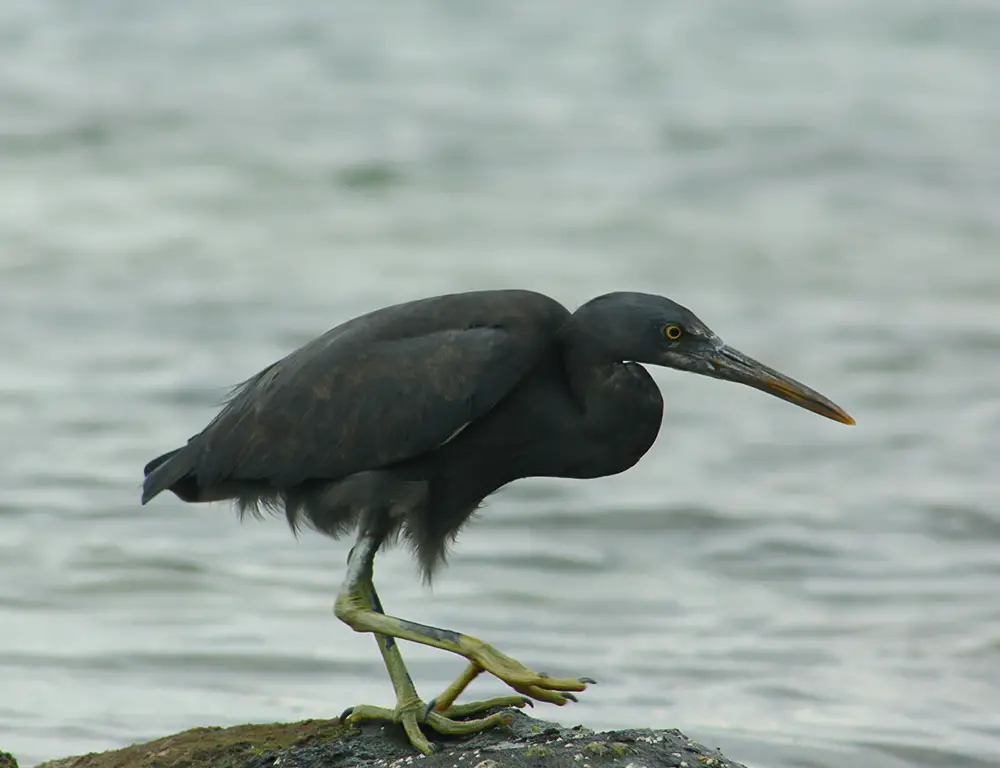
The Pacific Reef Heron (Egretta sacra) is currently classified as being of “Least Concern” on the International Union for Conservation of Nature (IUCN) Red List. This classification suggests that the species is not facing any immediate threats of extinction.
However, this does not mean that conservation efforts are unnecessary. Here are some points regarding the conservation status of the Pacific Reef Heron:
Population Trends
Overall, the population of Pacific Reef Herons is stable across its range. However, there may be localized declines in certain areas due to habitat degradation, disturbance, or other factors.
Habitat Loss and Degradation
Coastal habitats, which are critical for the survival of Pacific Reef Herons, are increasingly threatened by human activities such as coastal development, pollution, and habitat destruction.
These activities can lead to loss of nesting sites, disruption of foraging areas, and decreased prey availability.
Climate Change
Rising sea levels, increased storm frequency, and other effects of climate change pose additional challenges to coastal habitats and the species that depend on them, including Pacific Reef Herons.
Changes in temperature and precipitation patterns can also impact prey availability and breeding success.
Human Disturbance
Human activities, such as recreational boating, fishing, tourism, and coastal infrastructure development, can disturb nesting colonies, disrupt foraging behavior, and cause habitat fragmentation.
In particular, disturbance during the breeding season can negatively affect nesting success and chick survival rates.
Conservation Measures
While the Pacific Reef Heron is currently considered to be of Least Concern, continued monitoring and conservation efforts are essential to ensure the long-term viability of the species.
Conservation measures may include habitat protection, restoration of degraded habitats, establishment of marine protected areas, and public awareness and education programs.
FAQs
Do Pacific Reef Herons migrate?
Pacific Reef Herons are generally sedentary, but some populations may undergo localized movements in response to food availability or breeding behavior changes.
How do Pacific Reef Herons communicate with each other?
Pacific Reef Herons communicate through vocalizations such as squawks and calls, which are used for territory defense, courtship, and signaling danger or threats within social groups.
What are the predators of Pacific Reef Herons?
Predators of Pacific Reef Herons’ eggs and chicks include large birds of prey, monitor lizards, snakes, and introduced mammals like rats and cats.
How do Pacific Reef Herons adapt to changing tides?
Pacific Reef Herons adapt to changing tides by foraging along exposed rocky shores, tidal pools, and coral reefs during low tide periods.
How long do Pacific Reef Herons live?
Pacific Reef Herons typically live for several years, with an average lifespan ranging from 5 to 15 years, depending on environmental factors.
To Recap
The Pacific Reef Heron emerges as a symbol of resilience and adaptability in the face of coastal challenges. Its unique color variations, solitary behavior, and vital ecological role highlight the intricate balance of nature’s tapestry.
While currently classified as “Least Concern,” ongoing conservation efforts are imperative to mitigate habitat loss, human disturbance, and climate change threats.
Preserving the Pacific Reef Heron’s coastal habitats safeguards its existence and protects the intricate web of life that relies upon these ecosystems.
By championing the conservation of this remarkable species, we uphold a commitment to biodiversity and the interconnectedness of all living beings, ensuring that future generations may continue to marvel at the beauty and diversity of our natural world.